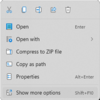- Local time
- 6:22 PM
- Posts
- 752
- OS
- Windows 11
Hello community!
This topic was actually raised in the comments section of multiple posts, but unfortunately got no response. So making a post with the hope of finding answers.
BACKGROUND
Problem 1
My internal disk had a dual boot setup, one Windows 10 and another Windows 11.
Last week I got my new Crucial MX500. I partitioned it according to my liking. Booted into Recovery and created an install.wim file for both the OS using DISM. I then applied them to the partitions on the new disk. I also configured the EFI partition properly.
When I tried to boot, the disk only booted from the Windows 10 partition and with Windows 11, I got a black/ blank screen that did nothing. Also, Windows 11 on the old (internal) disk did not boot via USB, even though it boots fine if connected directly to the SATA port.
So I booted into Windows 10 (on the new disk), installed Macrium Reflect and cloned the Windows 11 partition from my old disk to the new disk. Now Windows 11 booted fine from the new disk, i.e. I successfully migrated all my data from the old disk to the new disk.
Can someone tell me why Windows 11 didn't boot? DISM was able to create and apply the image successfully without errors, yet the device didn't boot.
Problem 2
I wanted to create a custom ISO of Windows 11 where a lot of settings have already been configured, my favourite apps pre-installed and configured, and also with all necessary drivers installed to make the image bootable from an external disk even on a Mac.
I used Sysprep for this purpose. The 1st 3 images are perfectly fine and bootable (even from external disk, and even on a Mac). Image 2 is basically image 1 with some additional programs and image 3 is image 2 plus some more programs. With image 4 (which is image 3 plus some additional programs/ tweaks) onwards, the system doesn't boot from an external disk. It boots fine from the internal disk.
Can someone tell me what's wrong with image 4?
More importantly, why did the DISM image of Windows 11 refuse to boot? I got no errors during creation or application of the image as both commands completed successfully. In fact, I used the same image to boot a VM, and it boots somewhat fine. I'm saying somewhat because the VM doesn't show the usual Windows 11 logo during boot. It boots directly from EFI. I have to check the option Enable EFI (special OSes only) in VirtualBox settings. I don't have to check that to boot my Windows 10 VM. But once booted, everything works perfectly fine.
My guess is it has something to do with the current Windows 11 image that I am using (image 4). Sysprep Generalized probably did not work the way it should, or there is some limit on how many times a system can be Sysprep Generalized, or there is some other reason. I am interested in knowing what exactly causes this kind of a behaviour.
Hoping to find an answer this time!
Thanks.
This topic was actually raised in the comments section of multiple posts, but unfortunately got no response. So making a post with the hope of finding answers.
BACKGROUND
Problem 1
My internal disk had a dual boot setup, one Windows 10 and another Windows 11.
Last week I got my new Crucial MX500. I partitioned it according to my liking. Booted into Recovery and created an install.wim file for both the OS using DISM. I then applied them to the partitions on the new disk. I also configured the EFI partition properly.
When I tried to boot, the disk only booted from the Windows 10 partition and with Windows 11, I got a black/ blank screen that did nothing. Also, Windows 11 on the old (internal) disk did not boot via USB, even though it boots fine if connected directly to the SATA port.
So I booted into Windows 10 (on the new disk), installed Macrium Reflect and cloned the Windows 11 partition from my old disk to the new disk. Now Windows 11 booted fine from the new disk, i.e. I successfully migrated all my data from the old disk to the new disk.
Can someone tell me why Windows 11 didn't boot? DISM was able to create and apply the image successfully without errors, yet the device didn't boot.
Problem 2
I wanted to create a custom ISO of Windows 11 where a lot of settings have already been configured, my favourite apps pre-installed and configured, and also with all necessary drivers installed to make the image bootable from an external disk even on a Mac.
I used Sysprep for this purpose. The 1st 3 images are perfectly fine and bootable (even from external disk, and even on a Mac). Image 2 is basically image 1 with some additional programs and image 3 is image 2 plus some more programs. With image 4 (which is image 3 plus some additional programs/ tweaks) onwards, the system doesn't boot from an external disk. It boots fine from the internal disk.
Can someone tell me what's wrong with image 4?
More importantly, why did the DISM image of Windows 11 refuse to boot? I got no errors during creation or application of the image as both commands completed successfully. In fact, I used the same image to boot a VM, and it boots somewhat fine. I'm saying somewhat because the VM doesn't show the usual Windows 11 logo during boot. It boots directly from EFI. I have to check the option Enable EFI (special OSes only) in VirtualBox settings. I don't have to check that to boot my Windows 10 VM. But once booted, everything works perfectly fine.
My guess is it has something to do with the current Windows 11 image that I am using (image 4). Sysprep Generalized probably did not work the way it should, or there is some limit on how many times a system can be Sysprep Generalized, or there is some other reason. I am interested in knowing what exactly causes this kind of a behaviour.
Hoping to find an answer this time!
Thanks.
My Computer
System One
-
- OS
- Windows 11
- Computer type
- Laptop
- Manufacturer/Model
- HP Envy dv7
- CPU
- Intel Core i7 3630QM
- Motherboard
- HP
- Memory
- 16 GB
- Graphics Card(s)
- Intel HD Graphics 4000 & Nvidia GeForce GT 635M
- Sound Card
- IDT High Definition
- Screen Resolution
- 1080p
- Hard Drives
- 1 TB Crucial MX500 on bay 1.
1 TB Seagate HDD on bay 2.
- Antivirus
- Windows Defender

















